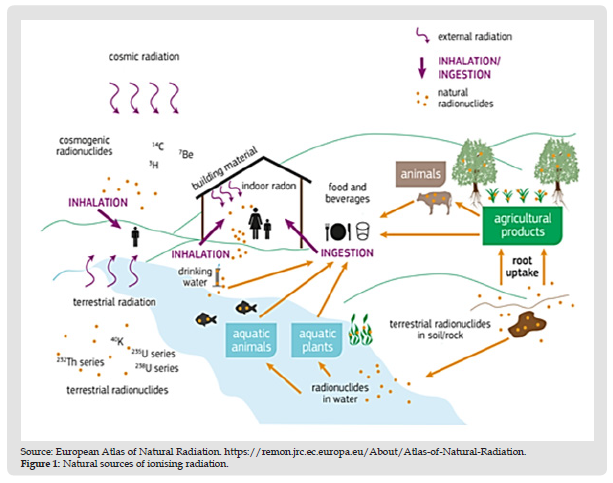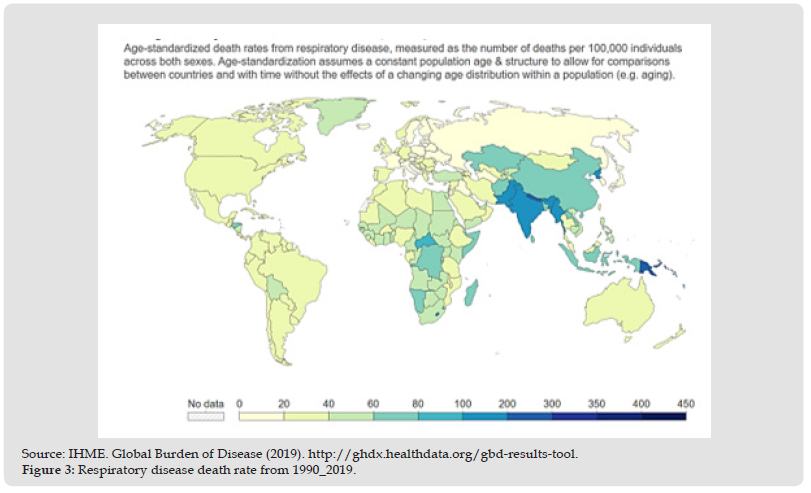Impact Factor : 0.548
- NLM ID: 101723284
- OCoLC: 999826537
- LCCN: 2017202541
Meirelles M1*, Vasconcelos H1,2 and Ferreira C1
Received: September 30, 2022; Published: October 18, 2022
*Corresponding author: Meirelles M, Faculty of Science and Technology, University of the Azores, Portugal
DOI: 10.26717/BJSTR.2022.46.007392
It is frequently accepted that weather and air quality factors contribute to the development and exacerbation of respiratory diseases and cardiovascular diseases. However, the literature is poor in the correlation between ambient radiation (gamma radiation) and respiratory diseases. This work is assumed in the insular context of the Azores. The base information (epidemiological and gamma radiation) used in this work corresponds to daily data from 2010 to 2020 and provided by the Statistics Service of the Hospital da Horta and The Network for the Continuous Surveillance of Radioactivity in the Environment, with a fixed station in Ponta Delgada (São Miguel_ Azores), whose management being the responsibility of the Portuguese Environment Agency. The practical study’s conclusions show an interesting relationship between hospitalization patterns and ambient gamma radiation levels.
Keywords: Gamma radiation; Hospital; Azores; Respiratory Diseases
The atomic structure of most elements contains a nucleus that is stable. Under normal conditions, these elements remain unchanged indefinitely. They are not radioactive. Radioactive elements, in contrast, contain a nucleus that is unstable. The unstable nucleus is in an excited state that cannot be sustained indefinitely; it must decay, to a more stable configuration. Decay occurs spontaneously and transforms the nucleus from a high energy configuration to one that is lower in energy. This can only happen if the nucleus gives off energy. The energy emitted by the excited nucleus is radiation. All radioactive elements have unstable nuclei; that is what makes them radioactive, (Henriksen [1]).
(Cinelli [2]), natural ionizing radiation is considered as the largest contributor to the collective effective dose received by the world population. The human population is continuously exposed to ionizing radiation from several natural sources that can be classified into two broad categories: high-energy cosmic rays’ incident on the Earth’s atmosphere and releasing secondary radiation (cosmic contribution); and radioactive nuclides generated during the formation of the Earth and still present in the Earth’s crust (terrestrial contribution), Figure 1.
In (Ramli, et al. [3]), natural terrestrial gamma radiation dose rate is an important contribution to the average dose rate received by the world’s population (UNSCEAR 1982, Tso and Leung 2000). Various surveys of terrestrial gamma radiation outdoors have been undertaken (Quindos et al 1991, Chikasawa, et al. 2001, Jibiri 2001, Goddard 2002) in advanced countries (Quindos, et al. 1994). Estimation of the radiation dose distribution is important in assessing the health risk to a population, and to serve as the reference in documenting changes to environmental radioactivity in soil due to human activities. According to Shenber (1997), large variations in dose rates due to terrestrial gamma radiation are found depending on where the measurement is made. Human beings are exposed outdoors to the natural terrestrial radiation that originates predominantly from the upper 30 cm of the soil (Narayana, et al. 1994).
Source: European Atlas of Natural Radiation. https://remon.jrc.ec.europa.eu/About/Atlas-of-Natural-Radiation.
Figure 1: Natural sources of ionising radiation.

Terrestrial radioactivity is mostly produced by the uranium and thorium radioactive families together with potassium. In most circumstances, radon, a noble gas produced in the radioactive decay of uranium, is the most important contributor to the total dose. Figure 2, shows the population-weighted average annual effective dose (in mSv/a) for each natural radiation source considering European populations. To monitor radioactivity in the environment, the Network for Continuous Surveillance of Radioactivity in the Environment (RADNET) was created, which can detect situations of abnormal increase in radioactivity. RADNET has a fixed station in Ponta Delgada, whose data were used in this study. Regarding the annual average values of the dose rate of gamma radiation in the environment, the data collected between 2010 and 2020 at the Ponta Delgada station correspond to values of the natural radioactive background of the place where the measurement took place. This natural radioactive background varies depending on local geology and altitude. In the specific case of the Autonomous Region of the Azores, due to its geographical location, the occurrence of detectable values of artificial radionuclides, namely 137Cs and 90Sr, is usual, although in very low concentrations. These occurrences are the result of the atmospheric deposition of these radionuclides, whose origin dates to the nuclear tests carried out in the 60s of the 20th centuries and the Fukushima nuclear accident, which occurred in the present century. http://rea.azores. gov.pt/reaa/100/riscos-ambientais/896/controlo-radiologicodo- ambiente. (Henriksen [1]), relate that it was noted earlier that radiation can produce biological effects. Around the turn of the century several experiments were carried out, which, would be characterized today as dangerous and foolhardy. It was found that ionizing radiation was capable of developing skin burns and could cause hair to fall out.
Source: European Atlas of Natural Radiation, capt. 9, pp. 174. https://remon.jrc.ec.europa.eu/About/Atlas-of-Natural-Radiation/ Download-pag.
Figure 2: Chart showing the population-weighted average annual effective dose (in mSv/a) for each natural radiation source considering European population.

Source: IHME. Global Burden of Disease (2019). http://ghdx.healthdata.org/gbd-results-tool.
Figure 3: Respiratory disease death rate from 1990_2019.

Figure 4: Scatter diagram for the value of monthly averages pathologies due to respiratory diseases versus intensity of gamma radiation levels (nSv/h).

Respiratory diseases are a type of diseases that affects the lungs and other parts of the respiratory system. Respiratory diseases may be caused by infection, by smoking tobacco, or by breathing in secondhand tobacco smoke, radon, asbestos, or other forms of air pollution. Respiratory diseases include asthma, chronic obstructive pulmonary disease (COPD), pulmonary fibrosis, pneumonia, and lung cancer. Diseases of the respiratory system are responsible for many deaths per year. Ritchie et al., 2019, refer that the first cause of death in the world is cardiovascular diseases (18.56 million) of people, in second place are oncological diseases (10.08 million) and in third place are respiratory diseases (3.94 million). 262 million people suffer from asthma. Nearly 90% of CPOC (chronic obstructive pulmonary disease) deaths in those under 70 years of age occur in low- and middle-income countries. Over 3 million people die each year from COPD an estimated 6% of all deaths worldwide. According to the Global Burden of Disease, 2019, the Figure 3 represent the respiratory disease death rate from 1990_2019.
The Azores are in the subtropical region of the North Atlantic and therefore heavily influenced by the North Atlantic Subtropical Anticyclone, also known as the Azores High. As it is a quasi-stationary high-pressure system, its position, intensity, development, and orientation determine the nature and characteristics of the air masses that reach the region, as well as the frequency and paths of waves and lows of the Polar Front of the North Atlantic which is, also, an important modeling system of weather in the Azores (Carvalho, et al. [4]). The island of Faial is located at the western end of the Central Group of the Azores archipelago. The island has the approximate shape of an irregular pentagon, 21 km long in the east-west direction and a maximum width of 14 km, which corresponds to an area of 172.43 km². The resident population is 14,356 inhabitants (2021), most of whom live in Horta city, the only municipality on the island. The climate is temperate oceanic, with average annual air temperatures that fluctuate on average between 13 °C in winter and 22°C in summer, with frequent windstorms and an average relative humidity above 79%, (Carvalho, et al. [4]).
The base information (epidemiological and gamma radiation) used in this work corresponds to daily data from 2010 to 2020. Data on the number of hospitalized individuals (hospitalized including those who visited the Emergency Department) with a diagnosis of a respiratory disease, totalizing 6246 patients. The data analyzed in this study were provided by the Statistics Service of the Hospital da Horta (Faial). The gamma radiation data were collected at automated station (Ponta Delgada). This station is the responsibility of the Portuguese Environment Agency. But the data are available on the website of the Azorean Regional Secretariat for the Environment and Climate Change. (http://rea.azores.gov. pt/reaa/100/riscos-ambientais/896/controlo-radiologico-doambiente) [5-8].
With the selected data, monthly averages were calculated, and a statistical analysis was performed using the SPSS software (Statistical Package for the Social Sciences) version 28 for Windows. The null hypothesis (H0) there is no correlation between radiation levels and the number of hospitalized individuals by respiratory diseases and the alternative hypothesis (Ha)_there is a correlation between radiation levels and the number of hospitalized individuals by respiratory diseases was formulated. The level of significance (α) to accept or reject the null hypothesis was fixed a α ≤ 0.05. Pearson’s correlation coefficient was used for inferential statistics. It was obtained, r =0.486 and p < 0.001, being r the Pearson correlation coefficient and p the value. It was found that p < α, therefore, the null hypothesis was rejected with a confidence level of 95%. Figure 4 represents the scatterplot for the two data series under study.
The objective of statistical inference was to allow the researcher to draw conclusions about a population from a sample, which is representative of the population under study. The correlation between radiation levels and the value of the monthly averages of respiratory pathologies is statistically significant, positive, and moderate (r = 0.486, p < 0.001). Thus, as environmental levels of gamma radiation increase, also the number of patients with respiratory pathologies increase.


